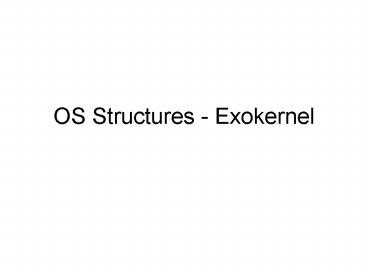OS Structures Exokernel - PowerPoint PPT Presentation
1 / 18
Title:
OS Structures Exokernel
Description:
Aegis processor environments. Exception context. Program generated. Interrupt context ... Aegis performance. Aegis - Address translation. On TLB miss ... – PowerPoint PPT presentation
Number of Views:116
Avg rating:3.0/5.0
Title: OS Structures Exokernel
1
OS Structures - Exokernel
2
Exokernel
3
Exokernel approach
- Separate protection from managament
- Export hardware resources securely
- Secure binding
- Visible resource revocation
- Abort protocol
4
Exokernel design
5
Exokernel tasks
- Track ownership
- Guard all resources through bind points
- Revoke access to resources
6
Design principle
- Expose hardware (securely)
- Expose allocation
- Expose names
- Expose revocation
7
Secure binding
- Decouples authorization from use
- Allows kernel to protect resource without
understanding their semantics - Example TLB entry
- Virtual to physical mapping performed in the
library (above exokernel) - Binding loaded into the kernel used multiple
times - Example packet filter
- Predicates loaded into the kernel
- Checked on each packet arrival
8
Implementing secure bindings
- Hardware mechanisms
- Capability for physical pages of a file
- Frame buffer regions (SGI)
- Software caching
- Exokernel large software TLB overlaying the
hardware TLB - Downloading code into kernel
- Avoid expensive boundary crossings
- Similar to the SPIN idea
9
Examples of secure binding
- Physical memory allocation (hardware supported
binding) - Library allocates physical page
- Exokernel records the allocator and the
permissions and returns a capability an
encrypted cypher - Every access to this page by the library requires
this capability
- Page fault
- Kernel fields it
- Kicks it up to the library
- Library allocated a page gets an encrypted
capability - Library calls the kernel to enter a particular
translation into the TLB - by presenting the capability
10
- Download code into kernel to establish secure
binding - Packet filter for demultiplexing network packets
- Exactly similar to SPIN
- How to ensure authenticity?
- Only trusted servers (library OS) can download
code into the kernel - Other use of downloaded code
- Execute code on behalf of an app that is not
currently scheduled - E.g. application handler for garbage collection
could be installed in the kernel
11
Visible resource revocation
- Most resources are visibly revoked
- E.g. processor physical page
- Library can then perform necessary action before
relinquishing the resource - E.g. needed state saving for a processor
- E.g. update of page table
12
Abort protocol
- Repossession exception passed to the library OS
- Repossession vector
- Gives info to the library OS as to what was
repossessed so that corrective action can be
taken - Library OS can seed the vector to enable
exokernel to autosave (e.g. disk blocks to which
a physical page being repossessed should be
written to)
13
Aegis an exokernel
14
Aegis processor time slice
- Linear vector of time slots
- Round robin
- An application can mark its position in the
vector for scheduling - Timer interrupt
- Beginning and end of time slices
- Control transferred to library specified handler
for actual saving/restoring - Time to save/restore is bounded
- Penalty? loss of a time slice next time!
15
Aegis processor environments
- Exception context
- Program generated
- Interrupt context
- External e,g. timer
- Protected entry context
- Cross domain calls
- Addressing context
- Guaranteed mappings implemented by software TLB
mimicking the library OS page table
16
Aegis performance
17
Aegis - Address translation
- On TLB miss
- Kernel installs hardware from software TLB for
guaranteed mappings - Otherwise application handler called
- Application establishes mapping
- TLB entry with associated capability presented to
the kernel - Kernel installs and resumes execution of the
application
18
ExOS library OS
- IPC abstraction
- VM
- Remote communication using ASH (application
specific safe handlers) - Takeaway
- significant performance improvement possible
compared to a monolithic implementation































